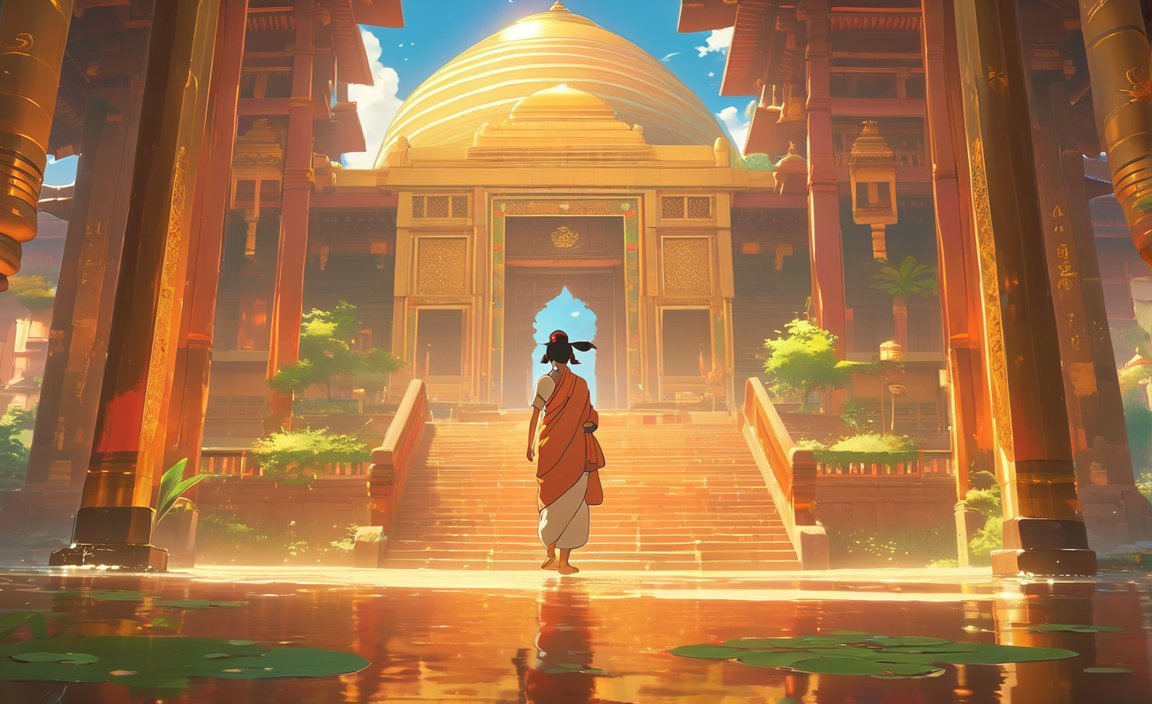Discover the fascinating ancient practice of yoga in India, where this intriguing cultural tradition has flourished for centuries. As we delve into the depths of India’s rich historical tapestry, we uncover the profound impact that yoga has had on individuals and society as a whole. Join us on this journey as we shed light on the captivating story behind one of India’s most intriguing practices.

Key Takeaways:
– India is a historic and culturally rich country with a diverse heritage.
– Throughout its history, India has never invaded any other country.
– India has a population of over 1.3 billion people, making it the second-most populous country in the world.
– The Indian army is the third-largest in the world, following China and the US.
– The word ‘shampoo’ originates from the Sanskrit word ‘champu’, meaning ‘massage’.
– India boasts over 300,000 mosques and more than 2 million Hindu temples, including globally renowned religious sites.
– Mawsynram in India receives the highest annual rainfall in the world, making it the wettest inhabited place on Earth.
– The Chenab Bridge in India holds the distinction of being the highest rail bridge globally.
– The Karni Mata Temple in India is devoted to rats and is home to thousands of worshipped and fed rodents.
Interesting Fact About India
India, with its rich cultural heritage and ancient history, never fails to amaze the world with its intriguing facts. Today, we’ll take a look at one such captivating detail that sheds light on the diverse and fascinating nature of this incredible country.
India: A Land of Marvels
India, one of the oldest civilizations in the world, has a history that spans over 100,000 years. Throughout this extensive timeline, India has never invaded any country. This fact speaks volumes about the country’s values and peaceful nature.
With a population of over 1.3 billion people, India boasts the title of the second-most populous country in the world. This vast population adds to the country’s diversity, making it a melting pot of cultures, traditions, and languages.
India’s Military Might and Etymology
When it comes to military strength, India holds its ground as having the third-largest army in the world. It trails just behind China and the United States, showcasing the nation’s commitment to safeguarding its borders and maintaining peace.
Did you know that even the word “shampoo” has its origins in India? The term is derived from the Sanskrit word “champu,” which means “massage.” This fascinating etymology highlights India’s profound influence on various aspects of global culture.
A Tapestry of Faith and Nature
India is a land where spirituality thrives, evident in the sheer number of religious sites spread throughout the country. With over 300,000 mosques and more than 2 million Hindu temples, India is home to some of the most visited religious destinations in the world. These sacred spaces reflect the country’s deep-rooted faith and spiritual practices.
But India’s wonders don’t stop at its religious sites. Nestled within its vast landscapes is Mawsynram, the wettest inhabited place on Earth. With an astonishing average annual rainfall of 11,871 mm, this region showcases India’s geographical diversity and its ability to nurture life in unique environments.
Engineering Marvels and Unconventional Temples
India’s pursuit of innovation has led to the creation of remarkable architectural achievements. The Chenab Bridge, for example, stands tall as the highest rail bridge in the world. Spanning the Chenab River, this engineering marvel is a testament to India’s prowess in infrastructure development.
And speaking of unconventional marvels, have you ever heard of a temple dedicated to rats? Yes, that’s right! In India, the Karni Mata Temple is home to thousands of rats that are worshipped and fed. This incredibly unique religious practice showcases the country’s ability to embrace diverse beliefs.
India’s rich tapestry of history, culture, and natural wonders encompasses these fascinating facts and so much more. These intriguing details highlight the country’s diverse landscape, its people, and their extraordinary achievements.
So the next time you think about India, remember that there is always something captivating waiting to be discovered—a world full of wonders that will leave you in awe of this incredible nation.
Here are some fun facts about Albania! Did you know that you can find all the interesting information about Albania on our website? Just click on this Albania fun facts link to discover more!
Looking for some fascinating facts about India? Look no further! Explore our collection of fun facts for India and be amazed by the rich history and diverse culture of this incredible country.
Are you curious about the cool facts surrounding India? Click on fun facts on India to uncover fascinating information that will leave you in awe of this beautiful nation.
Discover the incredible wonders of India! Click on cool facts about India to explore intriguing insights about this culturally-rich country.
Quench your curiosity about India with our collection of fun Indian facts. Prepare to be captivated by the interesting stories and remarkable achievements of this incredible nation.
Are you interested in learning more about the United Kingdom? Discover a wide array of fascinating information about the UK with our collection of UK fun facts. Click now and let the adventure begin!
[Outline 3: Historical background and origins of the interesting fact]
India, a country with a rich and diverse history, is known for its numerous contributions to various fields. From mathematics and science to literature and spirituality, India has made lasting impacts. One remarkable fact that showcases India’s ancient wisdom and insight is the practice of yoga, which has its historical background and origins deeply rooted in the country’s culture.
Origins of Yoga:
The practice of yoga dates back thousands of years in India. It originated in the Indus Valley Civilization, one of the oldest urban civilizations in the world, which thrived in the northwestern regions of the Indian subcontinent around 2600-1900 BCE. The ancient yogis developed a holistic system of physical, mental, and spiritual practices, known as yoga, to attain self-realization and experience higher states of consciousness.
Historical Background:
Yoga gained prominence during the Vedic period, which began around 1500 BCE. The Vedas, ancient texts composed by sages, contain knowledge and wisdom passed down through generations. Within the Vedas, references to yoga can be found in the form of hymns and philosophical ideas.
One of the earliest written texts specifically dedicated to yoga is the Yoga Sutras of Patanjali, believed to have been written around the 2nd century BCE to the 5th century CE. Patanjali’s Yoga Sutras provide a systematic and comprehensive framework for practicing and understanding yoga. It is considered a foundational text for yoga philosophy and practice.
Throughout history, various schools and lineages of yoga emerged, each offering unique approaches and techniques to achieve spiritual and physical well-being. These traditions, such as Hatha Yoga, Bhakti Yoga, and Karma Yoga, contributed to the evolution and diversification of yoga practices.
Impact and Global Spread:
Over time, yoga’s popularity grew beyond the borders of India. It began to captivate the interest of scholars, philosophers, and seekers in other parts of the world. In the 19th and early 20th centuries, influential figures like Swami Vivekananda and Paramahansa Yogananda introduced yoga philosophy to the Western world, sparking curiosity and a fascination for this ancient practice.
Today, yoga has become a global phenomenon, embraced by millions of people worldwide. Its benefits, which include increased flexibility, improved physical health, reduced stress, and enhanced mental well-being, have attracted people from all walks of life.
As yoga gained recognition and acceptance in the West, it underwent transformation and adaptation into various styles and practices. From Ashtanga Yoga to Vinyasa Yoga, from Yin Yoga to Bikram Yoga, practitioners have diverse options to explore and find the style that resonates with them.
Yoga has also evolved into a billion-dollar industry, with yoga studios, retreat centers, and wellness festivals flourishing across the globe. It has become a symbol of holistic living and mindfulness, inspiring people to cultivate a deeper connection with their bodies, minds, and spirits.
Key Takeaways:
- Yoga originated in ancient India and has a history dating back thousands of years.
- The Indus Valley Civilization and the Vedic period played significant roles in the development of yoga.
- The Yoga Sutras of Patanjali provide a foundational framework for understanding yoga philosophy and practice.
- Various schools and lineages of yoga emerged, offering diverse approaches and techniques.
- Yoga’s popularity spread beyond India’s borders, attracting interest and followers worldwide.
- Yoga’s benefits include physical fitness, stress reduction, and enhanced mental well-being.
- Yoga has become a global phenomenon and a billion-dollar industry.
Sources:
- Tourism Teacher – 25 Fascinating History Facts About India
- Britannica – India
[Outline 4: Significance and Impact of the Interesting Fact on Indian Society]
India, a land of immense cultural diversity and rich heritage, is known for its fascinating traditions and practices. Among these, the ancient practice of yoga holds a significant place. The practice of yoga in Indian society carries deep meaning and has a profound impact on individuals and the broader community.
The Significance of Yoga in Indian Society
Yoga, with its historical background deeply rooted in Indian culture, has been embraced and cherished for thousands of years. Originating from the Indus Valley Civilization, yoga gained prominence during the Vedic period and can be found in ancient texts like the Vedas and the Yoga Sutras of Patanjali. It has evolved and diversified throughout history, with various schools and lineages emerging.
In Indian society, yoga holds immense significance as a holistic practice that encompasses physical, mental, and spiritual well-being. It is deeply ingrained in the fabric of Indian culture and is considered a way of life rather than just a mere exercise routine. Yoga is viewed as a means to achieve self-realization, inner peace, and a harmonious connection between body, mind, and soul.
The Impact of Yoga on Indian Society
Yoga has had a lasting impact on Indian society, playing a pivotal role in shaping the lives of individuals and communities. Its practice transcends barriers of caste, religion, and social status, and acts as a unifying force for a diverse and multicultural society.
- Promoting Physical and Mental Health: The practice of yoga in Indian society has contributed to the overall well-being of individuals. Yoga postures, known as asanas, help improve flexibility, strength, and balance. The breathing techniques and meditation involved in yoga promote relaxation, reduce stress, and enhance mental clarity. By emphasizing the importance of a healthy lifestyle, yoga has helped combat lifestyle diseases and promoted overall vitality.
- Preservation of Tradition: Indian society is known for its constant attempt to balance tradition and modernity. Yoga, deeply rooted in ancient Indian culture, serves as a link to the country’s rich heritage. The practice of yoga has been passed down through generations, preserving traditional knowledge and wisdom. It acts as a reminder of the timeless traditions and values that shape Indian society.
- Fostering Inner Harmony: In a society characterized by societal hierarchy, yoga provides a path to inner harmony and equality. The practice encourages individuals to look beyond external differences and connect with their inner selves. This fosters a sense of unity, empathy, and acceptance among people from various backgrounds, contributing to social cohesion and harmony.
- Promoting Spiritual Growth: India, the birthplace of four major religions, including Hinduism and Buddhism, has a deep spiritual heritage. Yoga, as a spiritual practice, helps individuals explore their inner selves, seek higher consciousness, and tap into their spiritual potential. The impact of yoga on Indian society is evidenced by the integration of yogic principles in religious rituals, devotional practices, and spiritual discourses.
Overall, the practice of yoga in Indian society has a multi-faceted impact, ranging from physical and mental health to the preservation of tradition, fostering inner harmony, and promoting spiritual growth. It serves as a powerful tool for individuals to navigate the complexities of a diverse society and find balance amidst the rapid changes and challenges of modern life.
Key Takeaways:
- Yoga is deeply rooted in Indian culture and has a rich historical background.
- The practice of yoga in Indian society encompasses physical, mental, and spiritual well-being.
- Yoga promotes physical and mental health, contributing to a healthier society.
- The practice of yoga preserves traditional knowledge and acts as a link to India’s rich heritage.
- Yoga fosters unity, empathy, and acceptance, promoting social cohesion.
- Yoga serves as a spiritual practice, helping individuals explore their inner selves and seek higher consciousness.
Citations:
– Indian Society and Ways of Living | Asia Society
– 10 facts about Indian culture that you should know | DW
Conclusion: The Enduring Legacy of Yoga in Indian Culture
Yoga, an ancient practice deeply rooted in Indian culture, has left an indelible mark on both individuals and society as a whole. Its enduring legacy can be traced back thousands of years to the ancient Indus Valley Civilization, where the foundations of yoga were laid. Throughout history, yoga has evolved and diversified, with various schools and lineages emerging to contribute to its growth.
The popularity of yoga has transcended borders, attracting interest worldwide and becoming a global phenomenon. Its benefits, which encompass physical fitness, stress reduction, and mental well-being, have made it a billion-dollar industry. However, the significance of yoga extends far beyond its commercial success.
Yoga serves as a powerful bridge linking individuals to India’s rich and vibrant heritage. By preserving traditional knowledge and embracing its historical background, yoga acts as a testament to the cultural depth and wisdom of the Indian people. It fosters unity, empathy, and acceptance, promoting social cohesion and creating a sense of belonging.
Moreover, yoga is not just a physical practice but a spiritual journey that guides individuals on a path of self-discovery and self-realization. It offers a means of exploring one’s inner self and seeking higher consciousness. In a society where mental and emotional well-being are becoming increasingly important, yoga provides a sanctuary for individuals to find balance and inner peace.
In conclusion, the enduring legacy of yoga in Indian culture is a testament to its profound impact on individuals and society. It has become more than just an exercise or a trend – it is a way of life that promotes physical and mental health, preserves traditional knowledge, and fosters unity among diverse communities. Through yoga, India’s rich heritage continues to thrive and inspire people around the world to embark on their own transformative journeys.
Key Takeaways:
- Yoga’s legacy can be traced back to the ancient Indus Valley Civilization and has evolved over thousands of years.
- Yoga’s popularity extends beyond India and has become a global phenomenon.
- Yoga offers numerous physical, mental, and spiritual benefits.
- Yoga acts as a link to India’s rich cultural heritage and promotes social cohesion.
- Yoga serves as a spiritual journey, guiding individuals on a path of self-discovery and self-realization.
Citation:
– Conclusion: An Enduring Legacy
– The desire to be remembered: A review and analysis of legacy

FAQ
Q1: What is the significance of India’s ancient practice of yoga?
A1: India’s ancient practice of yoga holds profound significance for both individuals and society as a whole. It is renowned for its ability to promote physical and mental well-being, improve flexibility and strength, and reduce stress. Additionally, yoga encompasses spiritual and philosophical aspects, making it a holistic practice that promotes self-awareness and inner balance.
Q2: How did India contribute to the field of mathematics and science?
A2: India has a rich history of contributions to mathematics and science. Indian mathematicians, such as Aryabhata, discovered the concept of zero and made significant contributions to fields like trigonometry and algebra. The University of Takshashila in India is considered the oldest formal university in the world. Additionally, India has made significant advancements in the field of medicine, with pioneers like Sushruta considered the father of surgery.
Q3: What are some interesting facts about Indian culture and heritage?
A3: Indian culture and heritage are incredibly diverse and fascinating. India is known for being one of the oldest and most diverse civilizations in the world. It has never been invaded by another country in the last 100,000 years and has a rich history dating back thousands of years. Indian culture is renowned for its traditions, languages, and cuisine. Moreover, India is the birthplace of four major religions, including Hinduism and Buddhism.
Q4: How does Indian society balance tradition and modernity?
A4: Indian society constantly strives to strike a balance between tradition and modernity. While tradition plays a significant role in shaping social dynamics, customs, and rituals, the introduction of foreign cultures and customs during colonization has had a significant impact on modern Indian society. The desire to preserve age-old traditions while embracing modern advancements is a continuous process of transformation within Indian society.
Q5: What role do castes play in Indian society?
A5: Indian society is divided into social ranks called castes, which are primarily determined by birth and are nearly impossible to change. Castes have historically influenced various aspects of Indian society, including societal hierarchy, professions, and social relationships. Despite efforts towards social reform and ending discrimination, caste divisions still exist in different parts of Indian society, impacting individual lives and interactions.
- Unlocking 2-Letter Words with U: The Definitive Guide - April 4, 2025
- Unlock Words with the Letters THREE: Top Unscramble Tools 2025 - April 4, 2025
- Master Scrabble: X & Z Words for High Scores - April 4, 2025
















